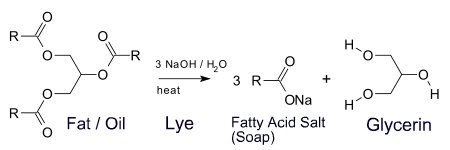Saponification -
Soap Making and Other Things
Saponification commonly refers to the reaction of a metallic alkali such as Lye (A.K.A. Sodium Hydroxide or NaOH) with an animal or vegetable fat, or oil to produce soap.
In this reaction, two products result: Soap and Glycerin. If you’re into chemical reaction formulas, see it below. Also see “The Cold Process” soap making which uses this reaction. It’s called the Cold Process because there is no need to add heat as the reaction itself draws in enough of its own heat.
Sodium Hydroxide (NaOH) is a caustic base or metallic alkali. If NaOH is used, a hard soap will result. If the caustic base potassium hydroxide (KOH) is used, a soft soap will result. KOH produces a more water-soluble soap and is often used in shaving creams.
In saponification, the metallic alkali, in this case sodium hydroxide (NaOH) or potassium hydroxide (KOH), breaks down the fat with which it is mixed. In soap making, fats used can either be vegetable oils like olive oil, or animal fats. When the oil or fat is mixed with the base the process takes place. It’s an endothermic reaction meaning it absorbs surrounding heat rather than releasing heat, which would be an exothermic reaction.

By Any Other Name
Remember that Sodium Hydroxide is the same as: Lye, NaOH, and Caustic soda.
Caution:
Sodium Hydroxide (Lye) is very dangerous to work with.
Eye protection is extremely important as is hand protection and clothing protection.
Saponification – Other than Soap …
Fire Extinguishers
Believe it or not, one cool example of saponification is certain fire extinguishers. Fires involving cooking oils are classified as “Class K” in the United States, and “Class F” in European and Australian systems. Fire extinguishers used to fight hot oil fires actually use saponification to extinguish the cooking oil fire. You see cooking oil is a “Combustible liquid” meaning it has a flash point (temperature at which it catches fire) above 100 degrees F. In contrast, a “Flammable Liquid” has a flash point below 100 degrees F.
In order to extinguish a cooking oil fire, the extinguisher uses a “Wet Chemical” which is typically potassium acetate, carbonate, or citrate. This “Wet Chemical” forms a soapy foam covering over the oil fire, and through saponification, which is an endothermic reaction (absorbs heat), lowers the surrounding temperature to below 100 degrees F, thus causing the flame to go out.
Oil Paintings
And what – Saponification can occur in oil paintings as well. Scientists discovered that metals contained in the color pigments used, sometimes react with the fatty acids in the oil used, and a soap like substance forms. This substance sometimes then moves to the surface of the dried paint, creating distortions on the surface. This has mostly been observed on paintings that are several hundred years old. But scientists have also found soap forming below the surface on newer paintings. They just haven’t been distorted by these soap substances reaching the surface – yet.
Corpses (Eww! – Not for the squeamish)
OK, and now something for you Forensic Scientist “wanna-bees”. Saponification occurs in dead corpses also. It’s a process known as “Adipocere” or “Grave Wax.” Anyway, most common in women, babies, and other fattier bodies, Adipocere or saponification, is the hydrolysis of fat in animal tissue such as body fat in corpses. It seems to occur best in an environment that lacks oxygen, is cold, and humid. These environments include wet ground, mud at the bottom of a lake or river, or in a sealed casket. It occurs in both embalmed and untreated corpses. Apparently it can begin within a month of the body being placed into this type environment, and can go on for centuries. (OK, you’re a certified Foresic Scientist. Go get a job on CSI or NCIS).
History of Saponification
The word “Soap” comes from either the Gallic (Gaulish) word “sapo” or a Germanic word “saipa”. Both sapo and saipa have their origins from the Latin word “sebum” meaning fat or tallow.
A common but apparently mythological story coming from the website of the “Soap and Detergent Association”, has it that Ancient Romans made animal sacrifices on a “Mount Sapo”. And when it would rain on Mount Sapo, the wood ash (which is caustic) mixed with the remaining animal fats and produced a soapy mixture that the locals collected and used for washing purposes. Interesting story, but most historians for a variety of reasons believe it to be - well, just a story.
The word “sapo” first appears in the ancient encyclopedia Naturalis Historia, published by Pliny the Elder in Latin between 77 and 79 AD.
In book 28, chapter 51, Pliny writes:
Prodest et sapo, Galliarum hoc inventum rutilandis capillis. Fit ex sebo et cinere, optimus fagino et caprino, duobus modis, spissus ac liquidus, uterque apud Germanos maiore in usu viris quam feminis.
-translation-
"There is also soap (sapo), an invention of the Gauls for making their hair shiny. It is made from tallow and ashes, the best from beechwood ash and goat fat, and exists in two forms, solid and liquid; among the Germans both are used more by men than by women."
Remember that in modern handmade soap making, after the saponification process completes, and when proper measurements are made, there is no lye left as it should all have reacted and changed into … (here’s the test) well …?
Yes correct, Soap and Glycerin. Excellent job. You pass Organic Chemistry class.
In factory mass-produced soaps, the Glycerin is typically removed. This is done for economic reasons. This nice luxurious component is stripped out in order to be used in other more costly products.
In Quality Handmade Soap, the Glycerin remains, leaving a beautiful, luxurious, moisturizing soap. That is why we at Brothers-Handmade are so proud to be associated with some of the finest Handmade Soapers.
Come see what your neighbors are making
at Brothers-Handmade.com™
Return from Saponification to Handmade Soap